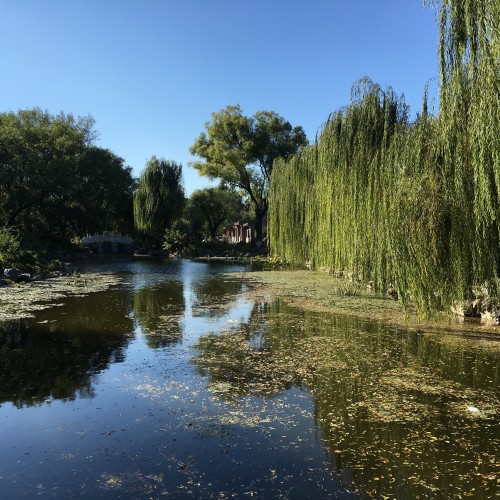Category Archives: China 2016
Probing the quantum nature of water
By James Dacey in Beijing on Friday 4 November
After enjoying clear blue skies for the first couple of days of my visit to Beijing, the breeze has disappeared and the smog has taken its hold. One local scientist told me this latest wave is due to pollution from factories south-west of the city, but others have told me it is difficult to pinpoint a particular source. Facemasks are being worn by every other person in the streets, but fortunately I’ve been sheltered by the walls and ceilings of Peking University (PKU).
View all posts by this author | View this author's profile
Science elevator pitches in Beijing
By James Dacey in Beijing
Could you provide a short entertaining presentation of your research to a non-specialist audience, leaving them feeling both enlightened and inspired? How about trying to do it in a non-native tongue? That’s what several Chinese researchers did on Wednesday evening at the Science Slam event at the European Delegation headquarters in Beijing. The event was part of a day-long communications training workshop aimed at researchers who want to communicate their research to the general public and improve their ability to apply for research grants.
View all posts by this author | View this author's profile
Computing in a chilly Beijing
By James Dacey
Today is my first day in Beijing and boy am I glad I packed my winter coat. Despite the clear blue skies, it was just above freezing point as I arrived at the Beijing Computational Science Research Center (CSRC) this morning, with an icy wind bringing an added chill factor. I was with my IOP Publishing colleague Tom Miller as we were delivering a presentation about scientific publishing and journalism and our taxi driver decided that 2 km from the venue was as far as he fancied going. So a brisk walk later we arrived with chattering teeth in need of a thorough thaw.
Located a few kilometres north-west of Beijing’s centre, the CSRC is within the Zhongguancun hi-tech zone. The majority of buildings within the technology hub are occupied by commercial firms, and our icy walk took us past the impressive modern offices of Baidu and Lenovo among other companies. The CSRC, however, is focused primarily on the application of computational modelling to fundamental science research. Its seven divisions include physical systems, quantum physics & quantum information, and materials & energy.
View all posts by this author | View this author's profile
Chatting about Chinese computing
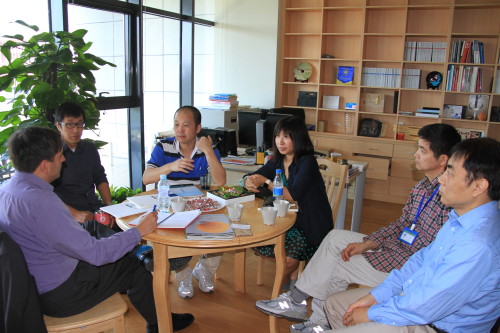
Calculated efforts: Matin Durrani (far left) in conversation with staff at the Beijing Computational Science Research Center, including Hai-Qing Lin (third left). (Courtesy: Mingfang Lu)
By Matin Durrani in Beijing, China
The last couple of days in the Chinese capital have been unusually damp and cool for the middle of June. Today, however, dawned sparklingly sunny as I headed off with my colleague Mingfang Lu from the Beijing office of the Institute of Physics, which publishes Physics World, to the Beijing Computational Science Research Center (CSRC) on the outskirts of the city.
Located on a shiny new software park, this sleek, five-storey building opened in March last year and looks just how you might expect the headquarters of IKEA to be – all minimalist corridors, big glass windows and the odd work of art dotted around. There’s even a fitness room in the basement. It’s currently got 43 full-time faculty, a third of whom are physicists, making this 45,000 m2 building – roughly the size of seven football pitches – seem remarkably sparse.
View all posts by this author | View this author's profile
Tsinghua University moves on up
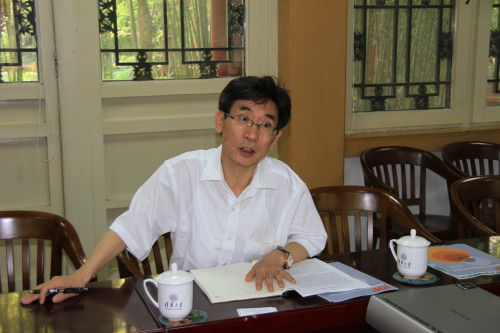
Figures at the ready: Qi-Kun Xue from Tsinghua University, which has 40,000 students. (Courtesy: Mingfang Lu)
By Matin Durrani in Beijing, China
I like big cities so I feel quite at home in Beijing with its skyscrapers, highways and endless traffic. Still, it was a pleasure yesterday on the third day of my visit to the Chinese capital to arrive at the green lawns of Tsinghua University. Situated in a former imperial garden, the university was founded in 1911 and is one of the top institutions in the country. According to the 2015–16 Times Higher Education rankings, it’s also the fifth best in Asia.
Quite why Tsinghua is so well rated quickly became clear as I listened to the numbers reeled off by Tsinghua’s vice-president for research Qi-Kun Xue: the university has 6000 research faculty and staff, a total research budget of $700m, and more than 40,000 students (two-thirds at postgraduate level). Like much of modern China, it’s benefiting from the government’s long-term commitment to growth through investment in facilities and infrastructure.
View all posts by this author | View this author's profile
China’s chief Moon scientist Ziyuan Ouyang outlines lunar plans
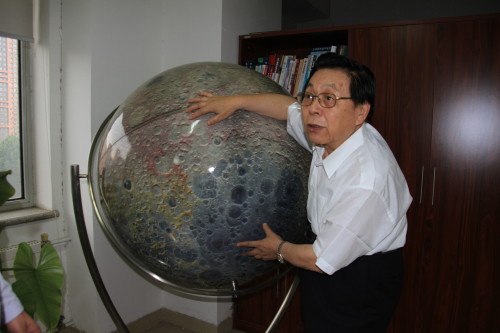
The Moon man: Ziyuan Ouyang in his office at the National Astronomical Observatories with a lunar globe covered with images taken by Chinese craft. (Courtesy: Mingfang Lu)
By Matin Durrani in Beijing, China
I caught up this morning on the second day of my visit to Beijing with Ziyuan Ouyang, chief scientist of China’s Moon programme at the National Astronomical Observatories, which lies not far from the city’s iconic “bird’s-nest” Olympic stadium.
I’d first met Ouyang on my last visit in 2011 when the country had so far launched two lunar missions – Chang’e 1 (which orbited the Moon for 18 months before crash-landing onto the lunar surface) and Chang’e 2 (another lunar orbiter that later moved off into interplanetary space).
China’s lunar efforts have continued and Ouyang explained to me what has happened since my last visit – and what the country plans to do next.
View all posts by this author | View this author's profile
China eyes new high-energy collider
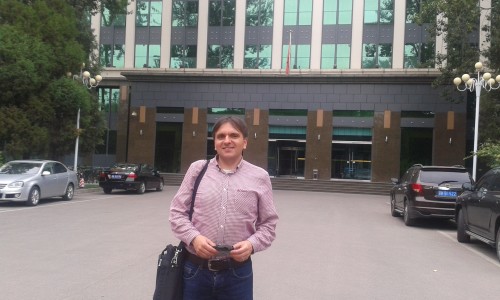
Matin Durrani outside the Institute of High Energy Physics in Beijing before interviewing Xinchou Lou.
By Matin Durrani in Beijing, China
I had just landed in Beijing this morning when I saw an e-mail from my colleague Mingfang Lu waiting for me on my phone. Mingfang, who’s editor-in-chief at the Beijing office of the Institute of Physics, which publishes Physics World, has been helping me to organize my itinerary for the next week as I gather material for our upcoming special report on physics in China. You may remember we published a Physics World special report on China in 2011 but so much has happened since then that we felt it’s easily time for another.
Mingfang’s e-mail was to say we would be off at 2.30 p.m. to interview Xinchou Lou, a particle physicist at the Institute of High Energy Physics, about the country’s ambitious plans for a “Higgs factory”. If built, this 240 GeV Circular Electron–Positron Collider (CEPC) would be a huge facility (50 km or possibly even 100 km in circumference) that will let physicists study the properties of the Higgs boson in detail. I say “if”, but knowing China’s frenetic progress in physics, it will almost certainly be a case of “when”.
View all posts by this author | View this author's profile
